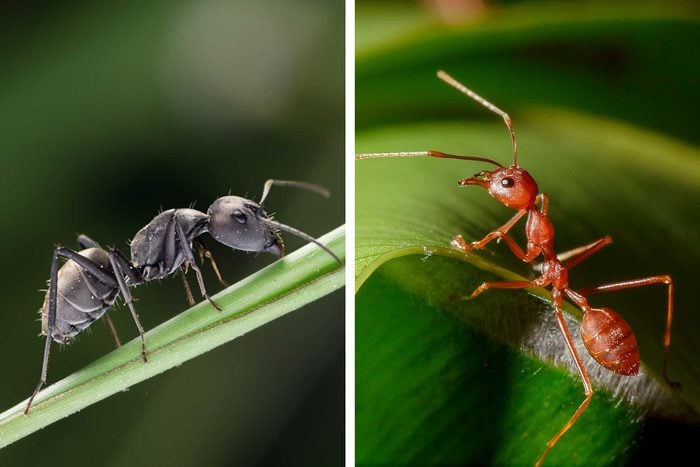Red Ants vs. Fire Ants: What’s the Difference?
Updated: Jan. 03, 2024

Learn the differences between red and fire ants (color is not one of them). The big similarity? Both are headaches for homeowners.
Our editors and experts handpick every product we feature. We may earn a commission from your purchases.
One difference between red ants and fire ants is how much pain they inflict. With fire ants, there’s the fiery pain of their sting. With red ants, there’s no sting. They occasionally bite, but pain is minimal.
However, whether they sting or bite, both of these insects cause lots of problems.
“Fire ants and ants in general are one of our biggest challenges, especially on the residential side,” says John Bell, a board-certified entomologist with Rentokil in Orlando, Florida.
Let’s compare these two tormentors.
On This Page
Red Ants vs. Fire Ants: What Do They Look Like?
The names are confusing because fire ants are red and red ants are red and black.
“A lot of ants are red, like Argentine ants, tawny ants and big-headed ants,” Bell says. “But there’s no official red ant recognized by entomologists. They all look similar to fire ants because of color.
“Most homeowners cannot tell the difference. Homeowners see ants are red and know they are ants, so they call them red ants. But there is no true red ant in our entomology world. However, there is a recognized fire ant.”
Red ants
Red ants are 1/4- to 1/2-in. long. Red ants have one small bump, called a petiole, between the thorax and abdomen.
Fire ants
Fire ants are smaller than red ants, 1/8- to 1/4-in. long. Unlike other ants, fire ants have two petioles. “But if you’re close enough to see the petioles,” Bell says, “that fire ant is probably stinging you at the time.”
Red Ants vs. Fire Ants: Where Do They Live?
Both can be found on every continent except Antarctica. Spanish traders in the 16th century helped spread fire ants by filling the ballast area of ships with soil, to be replaced by cargo in a new port. That soil was then dumped at the destination, spreading these pests.
In the U.S., red and fire ants thrive mostly south of the Mason-Dixon Line.
Red ants
Red ants live in soil, under leaves, in trees and on plants. They invade homes through cracks and crevices.
Fire ants
Fire ant colonies make messy mounds of soil, up to one foot across, formed as ants dig tunnels.
“Fire ants live in soil around the structure,” says Bell. “In rainier times when soil gets moist, fire ants move mounds to higher ground, which is typically close to the home structure, and will go inside where there is food but no moisture.”
Once in the house, fire ants look for protein. Bell says he’s responded “eight to 10 times” to calls of fire ants in a baby’s crib, attracted by leftover milk high in protein.
“The fire ant sends pheromones back to the colony, and other fire ants follow,” he says. “You get ants in the crib and the baby turns over. The ants feel under attack and attack the baby.
“When we get this kind of call, it’s not, ‘We’ll be out there tomorrow.’ We get out there quickly.”
Red Ants vs. Fire Ants: Behavior
Red ants
Red ants can tunnel into wood beams in your home. They leave small piles of dirt on your lawn and in sidewalk cracks. And they typically don’t bite.
“If I put my hand close to Argentine ants, they will scoot over it,” says Bell. “If I did the same with fire ants, my hand would be covered quickly and they would be stinging me a lot.”
Fire ants
Bell says fire ants have stung him many times.
“The stinger injects venom and your hand or whatever body part feels on fire,” he says. “It sends out a pheromone, and you look down and see all sorts of ants stinging you. Your entire hand swells and pustules form and harden. These go away, but there is the risk of anaphylactic shock, which can be deadly.”
Red and fire ants can affect electronic boxes. “Ants are attracted to magnetic fields and the warm area around electric utility boxes,” says Bell. “Soil, especially from fire ants, mounds up around electrical boxes and disrupts the circuitry. A large population of tawny ants in Texas once shut down a refinery in Houston.”
Red Ants vs. Fire Ants: How To Get Rid of Them
Treatment is the same for both. Homeowners can buy natural oils and products like Amdro Ant Block Insect Killer, which can be effective in the short term. “But use all of the product spread across your entire yard, not just on one mound,” says Bell. Stored products lose effectiveness after a couple of months.
Professional extermination companies rely on chemicals not available to homeowners with longer-lasting effectiveness, says Bell. According to the University of Florida Institute of Food and Agricultural Sciences (UF/IFAS), scientists tried releasing a parasitic fly to attack and control fire ants.
Bell says DIYers can control ants by following product instructions. “Mostly, though, I recommend hiring a pro,” he says. “I am biased, of course. With a pro, you’re not just buying the product but also experience, knowledge and guarantees.”
